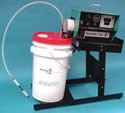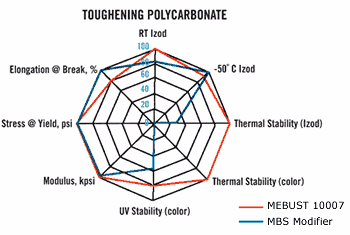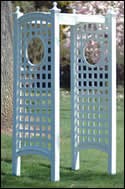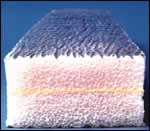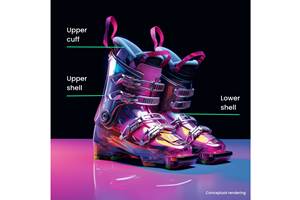Colorants and Additives Make a Splash at NPE 2003
Molders, extruders, and compounders found a host of new additives, including colorants, compatibilizers, impact modifiers, foaming agents, and processing aids.
Additives that enhance the appearance, processing, and mechanical performance of plastics made their debut last month at NPE 2003 in Chicago. New entries ranged from specialty colorants to novel nanoclay concentrates and unique compatibilizers for producing high-performance PP alloys.
Attendees also found a variety of new processing aids, lubricants, and mold releases. Four companies featured new offerings for impact modification of polyolefins, polystyrene, and engineering thermoplastics. Other new additives include nucleating and foaming agents, PVC heat stabilizers, antioxidants, and flame retardants.
‘Special-effect’ colors
There was a good showing of new colorant offerings, with “special-effect” types at center stage. Teknor Color Co. introduced Magic Color Concentrates, which use the Variocrom “color-variable” pigments developed by BASF Corp.These pigments confer iridescent, multi-color effects that shift with the angle of lighting and viewing (see cover photo). Custom formulations are available for use with PE, PP, PS, PC, and ABS. Standard colors available include red, green, gold, purple, violet, blue, autumn, purple-green, and green-gold.
Special-effect colorants launched by Calsak Polymers & Colorants include metallic-flake colors for all thermoplastics (see cover photo) and marble colors for polyolefins and styrenics. Also new are granite colorants for any thermoplastic with HDT up to 500 F, and pearl colors for styrenics, polyolefins, acetal, PC, and nylon.
Milliken Chemical showcased its recently introduced ClearTint colorants for PP. They produce bright, clean, transparent colors (also shown on the cover).
Polymer Color Services showcased custom “Clear View” color concentrates with built-in clarifying properties based on Milliken technology. They are said to make most homopolymer PP resemble clarified PP. The company is also offering new “smell, taste, and sight” concentrates for thermoplastics. These combine color, aroma, and even taste effects for uses ranging from novelty items and packaging to dental mouthguards.
Engelhard showed a new mica-based non-metallic pigment that brings a luxurious metallic gold effect to molded or extruded plastics. Lumina Brass pigment features higher chromaticity, color purity, brightness, and hiding power than traditional non-metallic brass colorants.
Shepherd Color Co. featured a new sparkle and luster pigment technology that’s based on silver-coated glass flakes. The perfectly flat glass-flake substrate is said to maximize reflectivity, so that visual effects can be achieved at lower loading than with other special-effects pigments, the company claims.
More specialty colorants
Also noteworthy are new color concentrates for TPEs, specialty carbon blacks, and new liquid colorant technology.
From Teknor Color comes a new line of color concentrates for use with TPOs, TPVs, and most other olefinic and styrenic TPEs. Teklite TPE concentrates have a special polyethylene carrier. Standard grades include blue, green, red, yellow, black, and white. Typical letdown ratios are 50:1 (2%) for all colors except black, which is 100:1 (1%). Applications include “soft-touch” grips, handles, and other components of housewares, appliances, hand and power tools, office devices, and personal-care products.
Cabot Corp. showcased new Black Pearls 3030, 4040, and 4060 carbon blacks for use in film masterbatches. Also on hand were two new high-performance conductive carbon blacks. Vulcan XC605 boasts excellent conductivity, surface smoothness, stiffness, dispersability and impact strength. Vulcan XC305 is said to provide a good cost-performance ratio for less demanding ESD applications.
Elftex P100, a carbon black for pressure pipe, is also new from Cabot. It boasts an improved balance of particle size, uv protection, moisture absorption, purity, and dispersability.
Degussa Engineered Carbons launched the Arosperse line of carbon blacks. Grades range from a very small particle size for uv protection of cable jacketing and geomembranes to a very large particle size that is said to produce very smooth surfaces of thin membranes and molded goods.
Finally, ColorMatrix showed off its new liquid colors and metering systems for extrusion and molding.
Novel additives debut
One of the more unusual additive introductions at the show was a family of nanoclay concentrates from PolyOne Corp. The result of a strategic alliance with nanoclay producer Nanocor Inc., Arlington Heights, Ill., these concentrates contain ultra-fine particles, roughly 1/10,000th the diameter of a human hair, that impart stiffness, fire resistance, and gas barrier at a fraction of the loadings required with traditional fillers. Some of the concentrates incorporate other functional additives, such as flame retardants and uv stabilizers, targeted at markets such as film and automotive or appliance parts.
Another interesting development is Crompton Corp.’s introduction of its first two Interloy compatibilizers. They are based on in-reactor PP alloy technology acquired from Basell that was previously used to make Hivalloy resins. This technology allows for the production of high-performance PP compounds and alloys with improved appearance and physical characteristics.
Interloy P1085HQ1 is a PP/PS graft copolymer that can compatibilize SEBS with PP in order to produce very high-impact blends. Interloy W1095H1 is a PP/PMMA graft copolymer that gives PP added gloss, weatherability, and scratch/mar resistance.
Smoother and slicker
Several new processing aids, lubricants, and mold releases were featured at the show. As reported previously, Dyneon brought out Dynamar FX 9614X and FX 5822X, two new fluoropolymer processing aids for polyolefins (see PT, May ’03, p. 98). They are said to offer significantly better performance than their predecessors—FX 9613 and FX 5920A—thereby allowing lower use levels and cost savings.
A processing-aid concentrate for unreinforced nylon 66 is new from DuPont. Containing a proprietary fluoropolymer in a nylon 66 carrier, Zytel FE310014 is said to cut cycle time and improve mold release of complex parts at a typical letdown of around 2%.
Croda Universal featured its new IncroMold line of internal mold releases for injection molding. Croda also added two new grades to its Incroslip line of novel slip additives for modifying the torque-release properties of plastic closures. Also new is Crodamide VRX, a new vegetable-based oleamide that is said to combine fast slip performance with excellent thermal stability.
Reedy International introduced a new and improved series of proprietary Saftec lubricant blends that are said to improve the foamability of highly filled wood, glass-fiber, or wollastonite composites for applications such as fencing, decking, and flooring. Saftec WSD is an internal lubricant blend that is said to facilitate processing of highly filled polyolefins and PVC. It reportedly enables processing at higher temperatures without degradation or discoloration. It is said to act like a processing aid, allowing for higher extrusion rates with excellent surface finish.
Reedy’s new Saftec WLB Edge 100 is an external lubricant blend that is said to prevent edge tear and melt fracture in films. Formulated to improve filler wetting, it is said to improve mixing, reduce viscosity, and permit lower process temperatures. It boasts excellent metal release at low use levels (up to 1%).
Axel Plastics Research Laboratories brought out three new products—Xtend 825 semi-permanent mold release for RTM thermoset composites; MoldWiz INT-1117EL processing aid for TPO, TPU, and other TPEs; and MoldWiz INT-38HM processing aid for nylon and other engineering resins (for details, see PT, May ’03, p. 98).
They can take a punch
New impact modifiers for uses ranging from polyolefins to styrenics were introduced by four companies. After having initially focused its Engage ethylene-octene polyolefin elastomers on automotive TPOs, DuPont Dow Elastomers has developed five new ethylene-butene grades for modifying a broader range of polyolefin materials in non-automotive uses. Field tests show promising results in applications ranging from foams, tubing, and extruded profiles to pet carriers, tool cases, footwear, and wire/cable. These grades are commercially available from the company’s new 300-million-lb/yr plant in Plaquemine, La.
The new product slate complements the higher performance Engage octene grades by offering grades that are less expensive and easier to process. For example, ENX 7467, a 1 MI, 0.6783 g/cc density butene grade, is a higher-performance, easier-to-process product said to provide good impact properties in TPO at the typical 20-30% use levels. It also toughens PP and HDPE at 10-20% addition levels.
Also claiming improved processing is ENX 7458, a 2.5 MI, 0.863 g/cc butene grade. Its patented broad molecular-weight distribution makes it well suited for PP and HDPE modification and is aimed at wire and cable as well as large-part and/or thin-wall applications such as bumper fascia and cladding.
New Engage ENX 7380 is a 0.8 MI, 0.870 g/cc, 45 Mooney, butene grade with enhanced toughness, improved melt strength, and higher molecular weight that allows it to serve as an extender for SEBS as well as a blending component with PP.
Engage ENX 7447 is a 5-MI, 0.865-g/cc, high-flow butene grade for modifying PP and HDPE. ENX 7270 is a 0.8 MI, 0.880 g/cc grade that is said to provide a good cost/performance balance in impact modification of PP, TPO, and HDPE.
Engage ENX 8556 is a new ethylene-octene grade of 2 MI and 0.870 g/cc that is said to provide excellent processability and clarity in extrusion applications.
Meanwhile, PolyChem Alloy introduced its new family of pelletized, ultra-low-temperature (<-131 F) MBS and ABS impact modifiers for use in PBT, PC, PC/PBT, and nylon (PT, May ’03, p. 99).
South Korea’s LG Chemical showcased its new Luprene transparent SBS elastomer, which is said to provide excellent impact toughness to PS while maintaining transparency.
For toughening styrenic resins, Maine Plastics, Inc. featured new impact modifiers made from recycled tires.
Plenty of fizz in CBAs
Several new nucleating and foaming agent concentrates were introduced by Reedy International, PolyChem Alloy, and Bergen International. Reedy’s new Saftec line of nucleating and foaming agents combine the company’s endothermic chemical blowing agents (CBAs) with surfactants that improve melt flow and melt strength. The line includes Saftec TFPE-504, a medium-temperature olefinic masterbatch that generates high gas volume for HDPE structural foam and extrusion. Another is TMIC-40A, a high-temperature polyolefin masterbatch designed for microcellular film and ribbon. TFP-940 is a styrenic masterbatch with an elevated melting point that allows higher processing temperatures and avoids agglomeration problems.
Reedy also unveiled several new additions to its Safoam line of CBA masterbatches. PC-20 is for PC and PC/ABS blends where high drying temperature is required, while RPC-20AS is said to eliminate staining and browning with flame retardants processed at high temperatures. Also new is Safoam PVC50-FP for PVC injection molding that is said to eliminate delamination and to provide a superior surface finish.
For microcellular foams, Reedy launched a new Safoam series of 3-micron particle-size CBAs. The five products provide density reduction of 3% to 50%, depending on the wall thickness. Safoam FPN3 is a powder with special surfactants for PS resins. FPN3-20 is a styrenic masterbatch of FPN3 powder for applications requiring only a little foaming. FPN3-40 is a companion product for applications that require greater density reduction.
Safoam RIC-FP is a powder with special surfactants formulated for polyolefins and RIC-50FP is an olefinic masterbatch of RIC-FP powder. Both are designed for low processing temperatures.
Meanwhile, Bergen International introduced Foamazol 62, an endothermic CBA for injection molding of high-shrink resins such as PP. This additive’s internal foaming pressure is said to allow processors to demold parts earlier and to reduce cycle time while preventing sinks. It is available in pelletized masterbatches for PP, ABS, PS, PE, and other resins.
A completely different foaming principle is embodied in PolyChem Alloy’s new PolyFoam Expancel MB, a polyolefin masterbatch of polymeric microspheres that contain a liquid hydrocarbon. (The spheres come from Expancel Inc.) When heated, the microspheres soften, and the vaporizing hydrocarbon causes them to expand, swelling the compound. Because it is encapsulated, the expanding gas cannot escape from the molten PE, PP, or TPO during extrusion or molding. This product therefore facilitates production of a homogeneous distribution of fine closed cells. It is targeted for wire and cable and shoe soles.
Expancel itself is also marketing a new pelletized form of its micro spheres for easier use in extrusion and molding. Also new is Expancel 098 MB 120, a grade that boasts higher temperature resistance.
Stabilizing PVC
Crompton Corp. showcased a number of new and improved PVC heat stabilizers, such as its Mark Low-Phenol 9300 Series, designed to improve indoor air quality by reducing phenol emissions from vinyl wall and floor coverings. These mixed-metal products include Mark 9301 Ba/Zn, said to give excellent initial color hold and long-term stability in calendered wall coverings, and both Mark 9302 and 9303 Ba/Zn for general-purpose filled compounds. Other grades are Mark 9304 Ba/Zn for clear or filled g-p compounds; 9305 Ba/Zn for plastisol clear wear layers on flooring; and 9306 Ca/Zn for clear and lightly filled calendering, molding, and extrusion. (Other new stabilizers from Crompton at the show are aimed at window profiles, pipe, and wire/cable—see PT, March ’03, p. 27; June ’03, p. 28.)
Other news in additives
There was also scattered news at the show in a variety of other additives:
Flame retardants: Techmer PM featured two new non-halogen FR concentrates. PM 9368E12 is a black MDPE grade for wire and cable insulation. It is said to achieve a minimum LOI of 31 and to have outstanding heat stability. PM 1250E4 is aimed at foamed LDPE acoustical and thermal insulation panels used in aircraft.
Antifog agents: Also new from Techmer is PM 11119E4, an improved antifog additive for LL/LDPE and HDPE food wrap and agricultural film.
Fillers: Heritage Plastics launched Minapol Additive Technology, a new complete line of mineral concentrates for specific polyolefin applications. Typically used at concentrations of 10% to 40%, they reportedly can reduce material costs by 1¢ to 3¢/lb. They also add stiffness and speed heat removal from the melt. HM-10 Max is 80% calcium carbonate in LLDPE. It’s said to maximize physical properties and productivity in PE film extrusion and to reduce cycle time in HDPE blow molding while meeting drop-impact and top-load requirements. HiCal concentrates 80% mineral in PP. They are said to provide a cost-effective alternative to filled PP compounds for injection molding. PolyCal EC is an LDPE mineral concentrate used to enhance polymer adhesion and increase line speed in LDPE extrusion coating.
Antioxidants: Crompton showed its new Naugard 900 Series of phenolic antioxidant/thermal-stabilizer blends that reportedly offer greatly improved protection of black glass-filled PP products such as battery cases.
Antistats: Tomen America featured its new Pelestat permanent anti-static additives based on nylon or polyolefin with special polyether segments. They are said to form a conductive polymer matrix in the host thermoplastic.
Multifunctional: Some harder-to-classify new additives include Cabot Corp.’s Nanogel hydrophobic silica aerogels, which can be used as carriers, thickeners, thixotropes, and matting agents.
Bayshore Industrial, div. of ICO Polymers, has a new MasterSeries line of proprietary additive concentrates for polyolefins. These include antiblock, slip, process aids, antioxidants, mineral filler, and various multifunctional products.
Related Content
Hybrid EPDM-TPE Adhesion Compounds for Automotive Industry
Kraiburg’s new compounds targeted to auto sealing and exterior sector applications and toolmakers.
Read MoreEther-Based TPUs for Broad Range of Industry Applications
BASF’s Elastollan 1400 TPU series can be used for applications ranging from railway pads, hoses and profiles to show soles.
Read MoreThermoplastic Elastomers With Recycled Content for Automotive Applications
Avient announced new grades of TPE to meet demand for recycled content.
Read MorePrintable Thermoset Polyurethane
Chromatic 3D Materials launched ChromaMotive D65, designed for additive manufacturing.
Read MoreRead Next
People 4.0 – How to Get Buy-In from Your Staff for Industry 4.0 Systems
Implementing a production monitoring system as the foundation of a ‘smart factory’ is about integrating people with new technology as much as it is about integrating machines and computers. Here are tips from a company that has gone through the process.
Read MoreMaking the Circular Economy a Reality
Driven by brand owner demands and new worldwide legislation, the entire supply chain is working toward the shift to circularity, with some evidence the circular economy has already begun.
Read MoreFor PLASTICS' CEO Seaholm, NPE to Shine Light on Sustainability Successes
With advocacy, communication and sustainability as three main pillars, Seaholm leads a trade association to NPE that ‘is more active today than we have ever been.’
Read More





